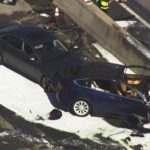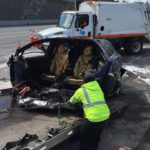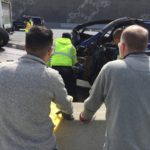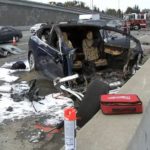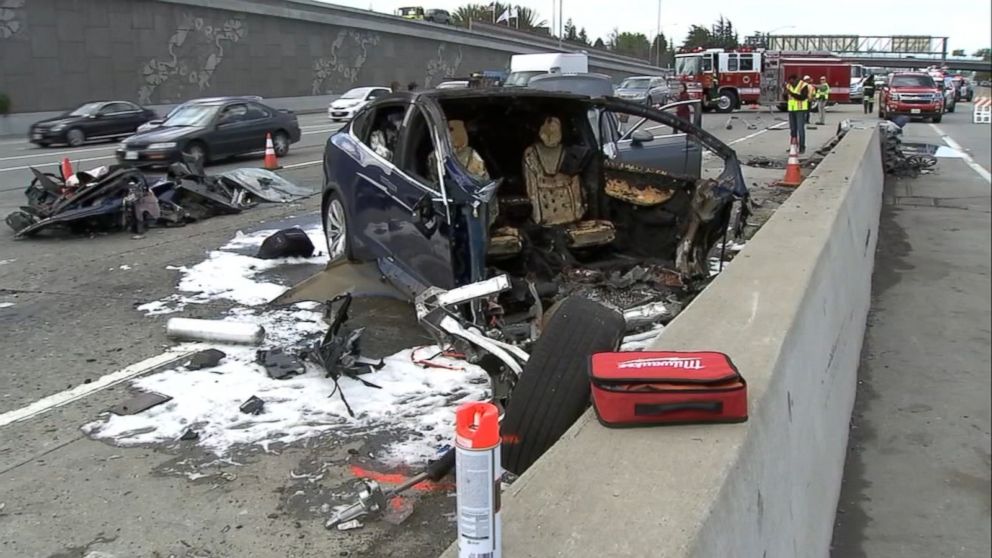

News
Tesla issues statement on fatal Model X crash as NTSB opens investigation
Tesla has opened up on what it knows so far about the fatal Model X crash that occurred last week near Mountain View, CA. According to the company, the ill-fated vehicle’s logs have not been retrieved yet due to the severity of the crash, but it is proactively cooperating with authorities to investigate the tragic accident.
The company noted that Tesla owners have driven over the same stretch of road where the fatal accident occurred about 85,000 times on Autopilot since the advanced driver-assist system was introduced back in 2015. Tesla vehicles on Autopilot have passed through the same area 20,000 times, and roughly 200 successful Autopilot trips are completed on the same stretch of road every day, notes the Silicon Valley-based electric carmaker.
The damage to the vehicle was extensive, with Tesla stating that it had not seen “this level of damage to a Model X” prior to last week’s fatal accident. Based on pictures taken from the aftermath of the crash, the entire front of the Model X was ripped off from the impact.
According to Tesla, one of the reasons behind this damage is that the crash attenuator — a safety barrier designed to reduce the damage to vehicles during road accidents — had not been replaced prior to the crash. Crash attenuators, also known as crash cushions and impact cushions, absorb and reduce the impact to a vehicle in the event of an accident.
In the case of the ill-fated Model X, however, the crash cushion was all but gone, causing the electric SUV to hit the concrete barrier. A comparison of the state of the crash attenuator could be seen below, with the left image being taken from Google street view and the right image being taken from a dashcam footage a day before the Model X accident.
- The aftermath of a fatal Tesla Model X accident. (Credit: Mercury News/Twitter)
- The aftermath of a fatal Tesla Model X accident. [Credit: Dean C. Smith/Twitter]
- The aftermath of a fatal Tesla Model X accident. [Credit: Dean C. Smith/Twitter]
- The aftermath of a fatal Tesla Model X accident. [Credit: Dean C. Smith/Twitter]
- The aftermath of a fatal Tesla Model X accident. (Credit: ABC News Radio/Twitter)
The batteries of the Model X caught fire in the immediate aftermath of the accident. In Tesla’s blog post, the company asserted that its vehicles’ battery packs are designed in a way that when a fire does occur, the flames spread slowly to give the car’s passengers time to exit the vehicle. As noted by the company, this appears to be the case during the accident, as there were no occupants on the Model X when its batteries caught fire.
Tesla expressed its sympathy to the family of the ill-fated Model X’s driver. The man was retrieved from his vehicle and taken to a medical facility, where he tragically succumbed to his injuries. Tesla has not released the name of the Model X’s driver, out of respect for the man’s family.
The National Transport Safety Board recently announced that it is sending two of its investigators to conduct a field investigation to study the fatal Model X crash. According to the NTSB, its investigators will look into factors involving the accident, including the post-crash fire from the car’s batteries.
2 NTSB investigators conducting Field Investigation for fatal March 23, 2018, crash of a Tesla near Mountain View, CA. Unclear if automated control system was active at time of crash. Issues examined include: post-crash fire, steps to make vehicle safe for removal from scene.
— NTSB Newsroom (@NTSB_Newsroom) March 27, 2018
The Tesla Model X has a 5-star safety rating from the National Highway Traffic Safety Administration (NHTSA). The electric SUV is equipped with 12 airbags and a huge crumple zone on the front, thanks to the absence of an internal combustion engine. Just last December, we reported on a Model X that got T-boned in a traffic accident in Dayton, Ohio. While the collision was severe, the Model X’s driver was able to walk away from the crash unharmed.

News
Tesla FSD v14.2.2 is getting rave reviews from drivers
So far, early testers have reported buttery-smooth drives with confident performance, even at night or on twisty roads.

Tesla Full Self-Driving (Supervised) v14.2.2 is receiving positive reviews from owners, with several drivers praising the build’s lack of hesitation during lane changes and its smoother decision-making, among others.
The update, which started rolling out on Monday, also adds features like dynamic arrival pin adjustment. So far, early testers have reported buttery-smooth drives with confident performance, even at night or on twisty roads.
Owners highlight major improvements
Longtime Tesla owner and FSD user @BLKMDL3 shared a detailed 10-hour impression of FSD v14.2.2, noting that the system exhibited “zero lane change hesitation” and “extremely refined” lane choices. He praised Mad Max mode’s performance, stellar parking in locations including ticket dispensers, and impressive canyon runs even in dark conditions.
Fellow FSD user Dan Burkland reported an hour of FSD v14.2.2’s nighttime driving with “zero hesitations” and “buttery smooth” confidence reminiscent of Robotaxi rides in areas such as Austin, Texas. Veteran FSD user Whole Mars Catalog also demonstrated voice navigation via Grok, while Tesla owner Devin Olsen completed a nearly two-hour drive with FSD v14.2.2 in heavy traffic and rain with strong performance.
Closer to unsupervised
FSD has been receiving rave reviews, even from Tesla’s competitors. Xpeng CEO He Xiaopeng, for one, offered fresh praise for FSD v14.2 after visiting Silicon Valley. Following extended test drives of Tesla vehicles running the latest FSD software, He stated that the system has made major strides, reinforcing his view that Tesla’s approach to autonomy is indeed the proper path towards autonomy.
According to He, Tesla’s FSD has evolved from a smooth Level 2 advanced driver assistance system into what he described as a “near-Level 4” experience in terms of capabilities. While acknowledging that areas of improvement are still present, the Xpeng CEO stated that FSD’s current iteration significantly surpasses last year’s capabilities. He also reiterated his belief that Tesla’s strategy of using the same autonomous software and hardware architecture across private vehicles and robotaxis is the right long-term approach, as it would allow users to bypass intermediate autonomy stages and move closer to Level 4 functionality.
News
Elon Musk’s Grok AI to be used in U.S. War Department’s bespoke AI platform
The partnership aims to provide advanced capabilities to 3 million military and civilian personnel.

The U.S. Department of War announced Monday an agreement with Elon Musk’s xAI to embed the company’s frontier artificial intelligence systems, powered by the Grok family of models, into the department’s bespoke AI platform GenAI.mil.
The partnership aims to provide advanced capabilities to 3 million military and civilian personnel, with initial deployment targeted for early 2026 at Impact Level 5 (IL5) for secure handling of Controlled Unclassified Information.
xAI Integration
As noted by the War Department’s press release, GenAI.mil, its bespoke AI platform, will gain xAI for the Government’s suite of tools, which enable real-time global insights from the X platform for “decisive information advantage.” The rollout builds on xAI’s July launch of products for U.S. government customers, including federal, state, local, and national security use cases.
“Targeted for initial deployment in early 2026, this integration will allow all military and civilian personnel to use xAI’s capabilities at Impact Level 5 (IL5), enabling the secure handling of Controlled Unclassified Information (CUI) in daily workflows. Users will also gain access to real‑time global insights from the X platform, providing War Department personnel with a decisive information advantage,” the Department of War wrote in a press release.
Strategic advantages
The deal marks another step in the Department of War’s efforts to use cutting-edge AI in its operations. xAI, for its part, highlighted that its tools can support administrative tasks at the federal, state and local levels, as well as “critical mission use cases” at the front line of military operations.
“The War Department will continue scaling an AI ecosystem built for speed, security, and decision superiority. Newly IL5-certified capabilities will empower every aspect of the Department’s workforce, turning AI into a daily operational asset. This announcement marks another milestone in America’s AI revolution, and the War Department is driving that momentum forward,” the War Department noted.
News
Tesla FSD (Supervised) v14.2.2 starts rolling out
The update focuses on smoother real-world performance, better obstacle awareness, and precise end-of-trip routing, among other improvements.

Tesla has started rolling out Full Self-Driving (Supervised) v14.2.2, bringing further refinements to its most advanced driver-assist system. The new FSD update focuses on smoother real-world performance, better obstacle awareness, and precise end-of-trip routing, among other improvements.
Key FSD v14.2.2 improvements
As noted by Not a Tesla App, FSD v14.2.2 upgrades the vision encoder neural network with higher resolution features, enhancing detection of emergency vehicles, road obstacles, and human gestures. New Arrival Options let users select preferred drop-off styles, such as Parking Lot, Street, Driveway, Parking Garage, or Curbside, with the navigation pin automatically adjusting to the user’s ideal spot for precision.
Other additions include pulling over for emergency vehicles, real-time vision-based detours for blocked roads, improved gate and debris handling, and extreme Speed Profiles for customized driving styles. Reliability gains cover fault recovery, residue alerts on the windshield, and automatic narrow-field camera washing for new 2026 Model Y units.
FSD v14.2.2 also boosts unprotected turns, lane changes, cut-ins, and school bus scenarios, among other things. Tesla also noted that users’ FSD statistics will be saved under Controls > Autopilot, which should help drivers easily view how much they are using FSD in their daily drives.
Key FSD v14.2.2 release notes
Full Self-Driving (Supervised) v14.2.2 includes:
- Upgraded the neural network vision encoder, leveraging higher resolution features to further improve scenarios like handling emergency vehicles, obstacles on the road, and human gestures.
- Added Arrival Options for you to select where FSD should park: in a Parking Lot, on the Street, in a Driveway, in a Parking Garage, or at the Curbside.
- Added handling to pull over or yield for emergency vehicles (e.g. police cars, fire trucks, ambulances).
- Added navigation and routing into the vision-based neural network for real-time handling of blocked roads and detours.
- Added additional Speed Profile to further customize driving style preference.
- Improved handling for static and dynamic gates.
- Improved offsetting for road debris (e.g. tires, tree branches, boxes).
- Improve handling of several scenarios, including unprotected turns, lane changes, vehicle cut-ins, and school buses.
- Improved FSD’s ability to manage system faults and recover smoothly from degraded operation for enhanced reliability.
- Added alerting for residue build-up on interior windshield that may impact front camera visibility. If affected, visit Service for cleaning!
- Added automatic narrow field washing to provide rapid and efficient front camera self-cleaning, and optimize aerodynamics wash at higher vehicle speed.
- Camera visibility can lead to increased attention monitoring sensitivity.
Upcoming Improvements:
- Overall smoothness and sentience.
- Parking spot selection and parking quality.

